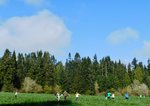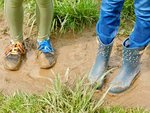

After a two year hiatus, Ridgefield School District’s Mini-Cispus program returned in April as fifth and sixth graders of Sunset Ridge Middle School descended on Whipple Creek Regional Park to enjoy the outdoors and learn new skills.
Teachers Amanda Burgess and Annie Pintler organized this year’s program.
“Mini-Cispus was an alternative outdoor school experience for two classes that didn’t get a chance to go to camp due to COVID,” said Burgess. “Instead of our four-day overnight, we ended up with two two-day day trips to a local park where they got to experience a small sampling of the activities that we do at regular camp.”
Burgess said it was nice to bring a modified version of the event back for the kids.
“We kept the fires burning and we were definitely ready to go back for sure,” she said. “It was a good refresher, and I’m glad these kids got a bit of something that would’ve otherwise had no outdoor school experience.”
Pintler said the Mini-Cispus program is a 50-year plus tradition in the city.
“It was nice to be able to at least give them a taste or snapshot of the learning and the experience that so many people in Ridgefield talk about and share,” said Pintler.
The Mini-Cispus program started in 1969 by Ridgefield resident and principal John Hudson Sr. The curriculum in the program is based on that of the Cispus Learning Center in Randle.
Burgess said the kids get a sense of independence during the program because they get a little time away from their teachers.
“The way we ran this part was teachers were stationed in one spot and we had 30 high school counselors who were in charge of the fifth and sixth grade students, so counselors were moving with the younger kids from station to station. They were hiking with them and moving to their next learning objective,” she said.
Pintler added that teachers taught the students mini lessons in things like soil and water testing on trails that had access to water near old growth trees.
“It was a completely new terrain for us,” said Pintler, who noted this was the first time the program had taken part at Whipple Creek.
Organizing this year’s program involved flexibility and changes because the teachers knew the interests of the kids would vary. They also had to change locations of certain activities to mitigate their impact on the park.
Besides water and soil testing, Burgess said there were a plethora of other activities to keep the students engaged.
“Those heavy science components that involve chemical reactions and things are super memorable,” she said. “We also had nature writing where kids wrote poems (and) we did oral storytelling which was a lot of fun. This time, we had an art project with bracelets the kids made from pony beads that represented the life cycle of the salmon. Between science learning, math learning, and art learning, we cover a lot of different curriculums and concepts.”